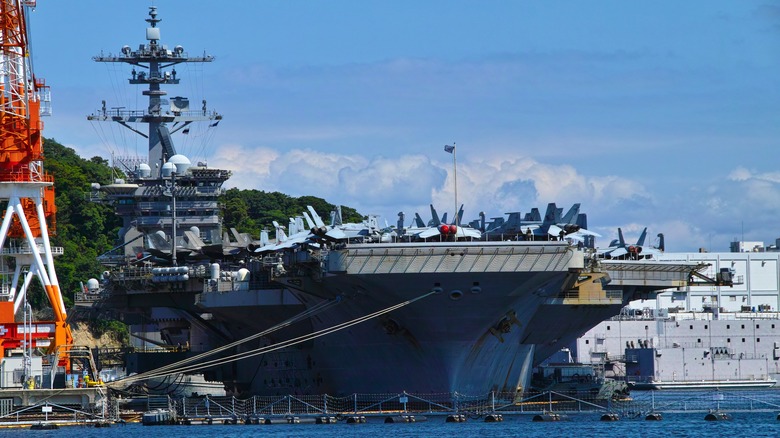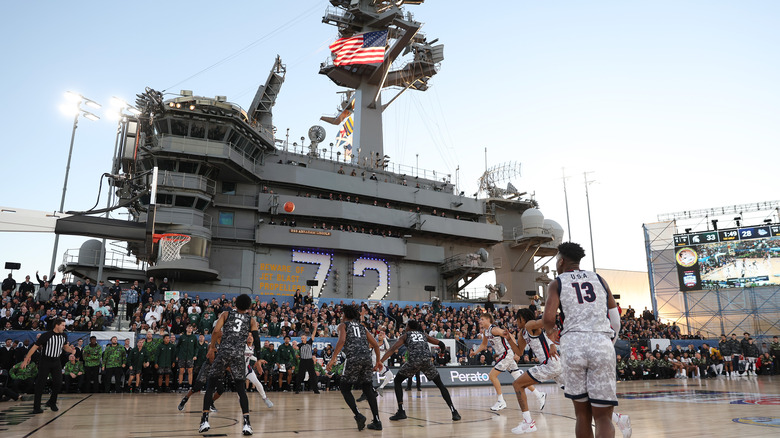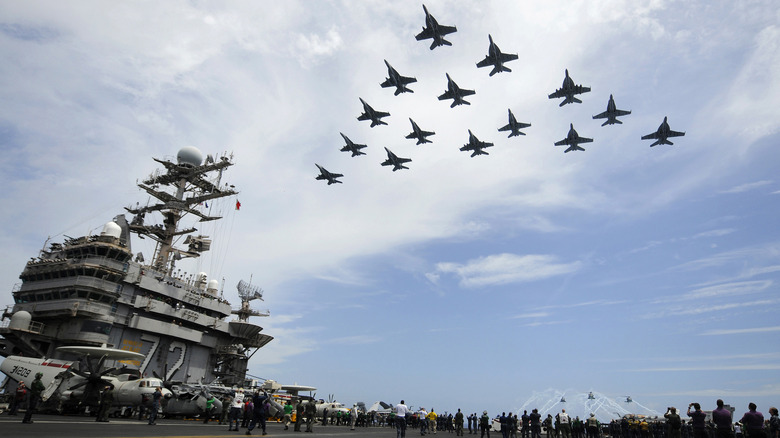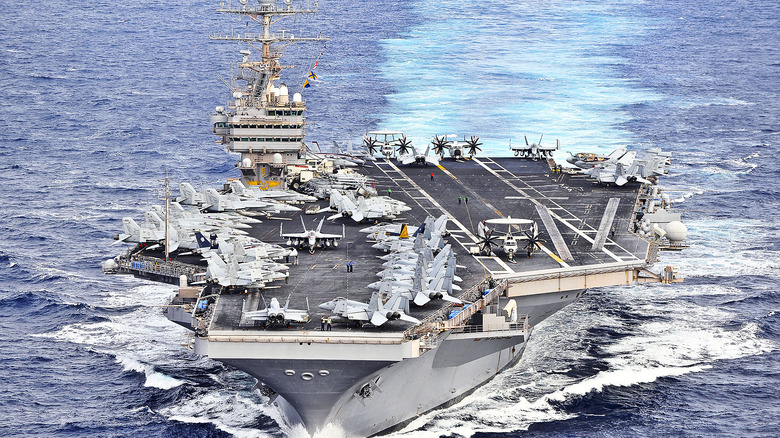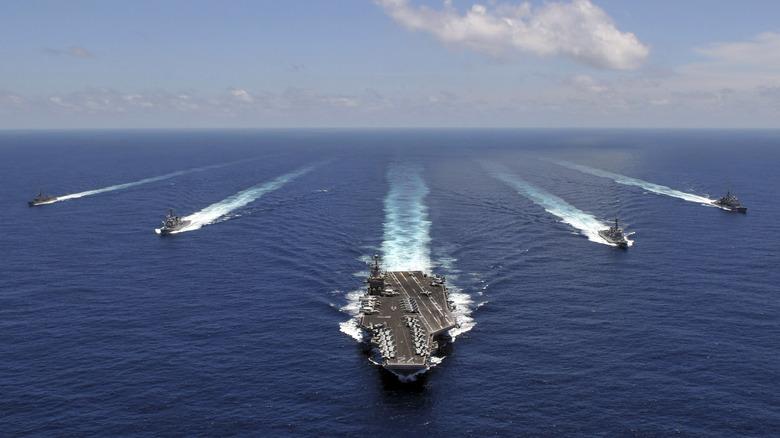Where Is The USS Abraham Lincoln's Homeport & How Many People Are Usually On Board?
Since its deployment over 30 years ago, the USS Abraham Lincoln (CVN 72) has traveled much of the globe, having transited from the Atlantic to the Pacific around South America and patrolled the waters of the Western Pacific, South China Sea, and Persian Gulf. When the ship isn't at sea — such as when it recently went under some crew-focused renovations — the USS Abraham Lincoln is typically moored in its homeport of San Diego.
Specifically, the USS Abraham Lincoln is stationed at Naval Air Station North Island, which covers 2,800 acres and is one of eight naval installations that make up the larger Naval Base Coronado in San Diego. The station has been in service since 1917 and is officially recognized as the "Birthplace of Naval Aviation." It's been the site of many historic moments, including the launch of Charles Lindbergh's The Spirit of St. Louis. The Lincoln is currently one of three American aircraft carriers that call North Island home, along with the USS Carl Vinson and the USS Theodore Roosevelt, which sails as part of the U.S. Navy's 7th Fleet.
The USS Abraham Lincoln is the flagship of the U.S. Navy's Carrier Strike Group 3, which is currently commanded by Rear Admiral Adan G. Cruz and includes heavily armed ships like the guided-missile cruiser USS Mobile Bay (CG 53) and the guided-missile destroyers of Destroyer Squadron (DESRON) 21, as well as Carrier Air Wing (CVW) 9. The USS Abraham Lincoln alone has a large crew that consists of 5,500 members, currently led by its Commanding Officer, Captain Pete "Repete" Riebe. As a floating airbase, nearly half of the carrier's crew are aircrew. If the ship needs to be crewed to full capacity, it can accommodate 2,480 aircrew and 3,200 sailors for a total of 5,680 people.
The USO has upgraded the amenities for the USS Abraham Lincoln crew
Thanks to the USO, the 5,500 crew members of the USS Abraham Lincoln will feel a little more at home while aboard, as the organization has recently performed renovations on common areas like the ship's library and lounge, each costing around $200,000 each. Built by a team of USO volunteers, contracted workers, and ship's crew, the USO has already provided similar upgrades to four other aircraft carriers. These upgrades include teal-colored bulkheads, wood-laminate flooring, wood accents, and artificial plants, as well as cushioned chairs by an electric fireplace, a gaming room, and a stadium-seating movie theater. Contemporary and steampunk-style artwork inspired by the vessel's namesake — President Abraham Lincoln — also adorn the lounge area, which is dubbed the USO Center.
Just as (if not more) important as the new creature comforts were improvements to communication so that the ship's sailors and other stationed crew can keep in touch with loved ones back home. Two teal-colored rotary dial phones are included in soundproof booths for privacy and the vessel's Wi-Fi has been upgraded so crew members can text, email, and even FaceTime their friends and family back on land. Captain Pete Riebe, the ship's commander, called the new USO Center "a peaceful and modern respite for our sailors and Marines to rest and recharge and to reach their families while using Wi-Fi while at sea, to watch movies in legitimate movie theater seating, and play video games."
The large crew operates a large ship
These new renovations to the lounge and library may be deeply appreciated by the crew of the USS Abraham Lincoln, but the ship has far more impressive technology embedded elsewhere. While it may not be the most advanced aircraft carrier in the world, the Nimitz-class vessel is still one of the most formidable. After all, it's nuclear — propelled by four steam turbines that are powered by two separate Westinghouse A4W nuclear reactors. These generate over 260,000 shaft horsepower — or 194 megawatts — allowing the carrier to travel at speeds exceeding 30 knots. That's particularly impressive considering how big the ship is: 1,092 feet long with a waterline length of 1,040 feet and an extreme beam of 252 feet. With a dead weight of nearly 23,000 tons, the USS Abraham Lincoln displaces up to a colossal 104,112 tons of water and can only navigate in waters that are at least 42 feet deep.
While it's not quite as big as the world's largest aircraft carrier, the Lincoln comes close and still has plenty of room for scores of fighter planes. Its flight deck is 252 feet wide and has an area of around 4.5 acres. This allows it to carry 90 helicopters and fixed wing aircraft, including nine squadrons that each consist of a pair of SH-60 Seahawk attack choppers, an EA-6B Prowler, a Northrop Grumman E-2 Hawkeye tactical airborne early warning (AEW) aircraft, a Greyhound Logistical support aircraft, and four fighter bombers (two Hornets and two Super Hornets). Four separate hangar elevators (three starboard and one port) and four steam catapults to launch the jets are also part of the flight deck.
The USS Abraham Lincoln is armed to the teeth
In addition to launching these aircraft into battle and other missions, the carrier needs to also defend itself. Fortunately for the crew, the USS Abraham Lincoln has plenty of armament, including four MK-38 Mod 2 25mm Machine Gun Systems, two RIM-116 Rolling Airframe Missile short-range surface-to-air missile launchers, two MK-57 Mod3 Sea Sparrow surface-to-air missile launchers, and two MK-15 20mm Phalanx CIWS, which are radar-guided, rapid-fire 20-millimeter Gatling guns capable of firing 75 rounds per second that are used for shooting down anti-ship missiles. Plus, the vessel is fitted with SLQ-25A Nixie torpedo countermeasures systems and an SLQ-32A(V)4 countermeasures suite that's designed to jam the radar of incoming guided missiles.
In addition to its radar-jamming countermeasures, the Lincoln has plenty of its own radar systems, which are used for defense, offense, and, of course, supporting its own aircraft. These systems include four MK-91 NSSM guidance systems, four MK-95 radars, AN/SPS-48E 3-D and AN/SPS-49(V)5 2-D air search radars, an AN/SPQ-9B target acquisition radar, and an AN/SPN-41 landing aid radar, as well as AN/SPN-46 and AN/SPN-43C radars that are used for air traffic control.
The carrier is returning to where it was first deployed
The USS Abraham Lincoln is one of 10 currently deployed Nimitz-class aircraft carriers. At the time of its 1988 launch, which was four years after its keel was first laid, the Lincoln was the largest the U.S. Navy had ever built. In 1991, it began its first official deployment and headed to the Persian Gulf after Iraq's invasion of Kuwait. However, after a violent volcanic eruption in the Philippines, the carrier led a 23-ship armada that evacuated nearly 45,000 people — the largest recorded peacetime evacuation of active-duty military personnel and their families.
The Lincoln did eventually make it to the Gulf, where it supported air operations during Operation Desert Storm, followed by assisting U.N. humanitarian operations in Somalia in 1993. Over the past three decades, it has spent most of its time in the Persian Gulf or in the Western Pacific. In 2022, as tensions heightened over Taiwan, the Lincoln sailed the South China Sea, before returning to San Diego for its recent renovations.
Now that the renovations are complete, the 5,500 crew members of the USS Abraham Lincoln are headed back to the Middle East to relieve the USS Theodore Roosevelt and increase American presence as the conflict between Israel and Iran continues to escalate. It's unclear when the ship will make its way home again to San Diego.
While it may currently be halfway across the globe, it's not hard to get a good look at the USS Abraham Lincoln whenever you'd like. That's because the vessel was used in the box office smash "Top Gun: Maverick" starring Tom Cruise, including scenes involving actual F/A-18 carrier qualification take offs and landings. So, even when the carrier is eventually decommissioned, its legacy will continue on the silver screen.
